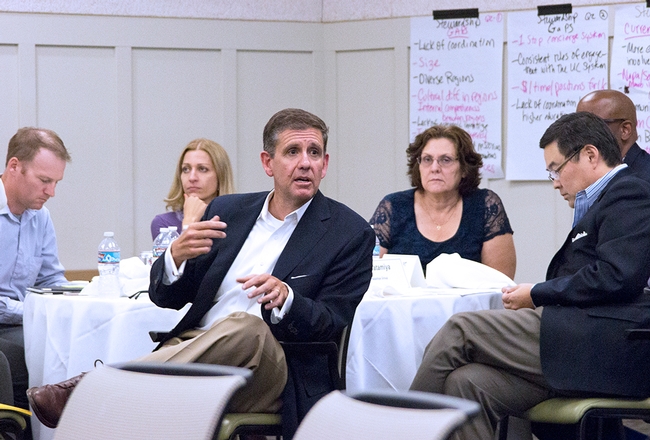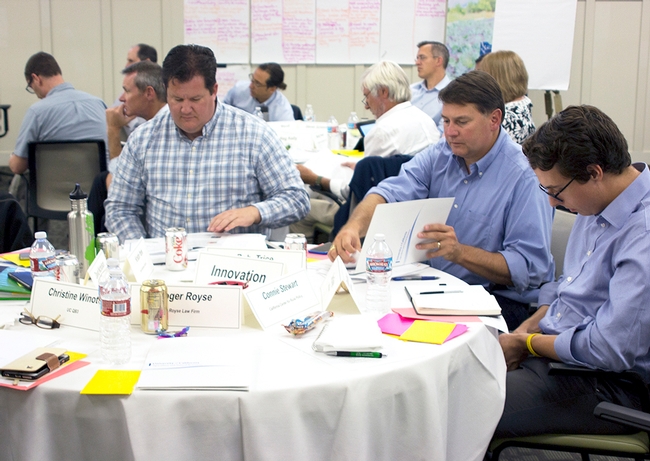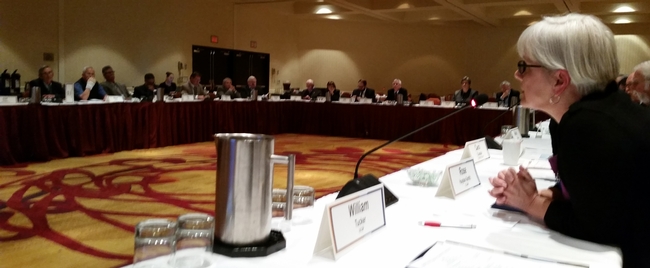Posts Tagged: David Doll
ANR develops innovation incubation strategy
“If UC ANR isn't an incubator, I don't know what is. Furthermore, I would argue that the partnership of our land-grant university system with Cooperative Extension is the original and most productive incubator that the world has ever seen,” VP Glenda Humiston wrote in the October-December 2015 issue of California Agriculture.
Since joining ANR, Humiston has been working to expand UC ANR's incubation activities by joining with diverse partners to develop a much broader innovation infrastructure specifically designed to support intellectual property, innovation, entrepreneurship, tech transfer, startups and commercialization aimed at agriculture, natural resources and rural communities.
“A lot of people have ideas, but they don't know how to be business leaders. An incubator connects them with the things they need to be successful as new entrepreneurs,” said Gabe Youtsey, chief information officer.
To kick off development of such a system, Humiston brought together 40 people on Aug. 30 with a wide range of expertise and representing a variety of sectors: agriculture, banking, business, government, technology and higher education – including leaders of several successful incubators. The purpose of the meeting, held at the ANR building in Davis, was to engage the group in developing a comprehensive strategy to nurture new technologies and innovative businesses for agriculture and natural resources.
“We're not looking to reinvent the wheel or duplicate existing efforts,” Humiston said, explaining that she hopes to support and leverage the strengths and efforts of partners.
Christine Gulbranson, UC senior vice president of research innovation and entrepreneurship, and Reg Kelly of UC San Francisco, who created QB3, – one of UC's best performing incubators – participated in the session. The quantitative biologists at UC Berkeley, UC San Francisco and UC Santa Cruz who comprise QB3 take on challenges in biology using physics, chemistry, and computer science. QB3's Startup in a Box provides legal and grant-writing help for biotech startups.
“We want to take the QB3 model and modify it for ANR,” Humiston said. “But we don't have the resources to build a statewide system by ourselves so we're catalyzing like-minded partners to jointly develop the needed statewide innovation infrastructure.”
Such an innovation system could benefit a wide array of entrepreneurs in rural areas and help to commercialize ideas generated by UC Cooperative Extension specialists and advisors.
“Over the past eight years, ANR researchers have filed 148 patents,” Humiston said. “However, it is unclear if many of those had the support they needed to go the next step.”
At the meeting, the group divided into five tables of eight people. Each table had representatives of UC ANR, various UC campuses, state and federal government, funding institutions, incubators, and different industries. They discussed issues around innovation, place, talent, stewardship and engagement, answering the following questions:
- What exists now?
- Where are the gaps that need to be filled?
- Which of these gaps could UC ANR help catalyze and fill, either with partners or on its own?
- How could this work to fill the gaps be funded?
- How do we measure success?
Conversations were lively and many ideas were brought forth for specific projects and other implementation. “It's really exciting,” said Humiston. “People were jazzed. Virtually all of the participants said they want to work with us on next steps.”
In addition to Humiston and Youtsey, AVP Wendy Powers and UCCE advisors David Doll and Andre Biscaro participated for ANR. Consultant Meg Arnold is writing up a report, which is expected to be released in early October.
ANR continues to focus on five strategic initiatives
VP Humiston has announced that ANR will continue to focus on the current strategic initiatives. Sustainable Natural Ecosystems (SNE), Healthy Families and Communities (HFC), Sustainable Food Systems (SFS), Endemic and Invasive Plants and Diseases (EIPD) and Water Quality, Quantity and Security (Water) will remain priorities for the next five years.
Through the development and implementation of ANR's Strategic Vision 2025, the division has identified these five initiatives as the best opportunities for ANR's considerable infrastructure and talent to seek new resources and new ways of partnering within and outside UC to find solutions for California.
In 2014, ANR conducted an assessment of the Competitive Grants Program to evaluate whether it was effectively addressing priority issues within the initiatives outlined in their respective plans. The report concluded that the grants program is reaching the goals of supporting short-term, high-impact projects and contributing policy-relevant outcomes that address significant agricultural, economic, and environmental and social issues in California. The strategic initiatives are also fostering collaboration and leveraging resources through the grants program and other activities. To read the summary of the Competitive Grants Program report, visit http://ucanr.edu/sites/anrstaff/files/204951.pdf.
A recent study of policy impacts of the ANR Competitive Grants program by UC Cooperative Extension specialists Clare Gupta and David Campbell found that funded projects are influencing various stages of the policy process: http://ucanr.edu/sites/anrstaff/files/241970.pdf.
ANR's Strategic Initiatives leaders include the following:
- David Doll, Sustainable Food Systems
- John Harper, Sustainable Natural Ecosystems
- Keith Nathaniel, Healthy Families and Communities
- Doug Parker, Water Quality, Quantity, and Security
- Cheryl Wilen, Endemic and Invasive Pests and Diseases
For more information about ANR's Strategic Initiatives, visit http://ucanr.edu/sites/StrategicInitiatives.
Strategic Initiative leaders respond to feedback from the Joint SI Conference
The Oct. 5-7, 2015, Joint Strategic Initiative conference had great participation, with 353 people attending. During the January Strategic Initiative (SI) leaders meeting with Bill Frost, we carefully reviewed the conference feedback. The conference evaluation survey had a good response rate (23%). A summary of responses to the closed-ended questions is at http://ucanr.edu/sites/2015jointsiconference. Below are some highlighted themes from the open-ended questions, and how we are planning to address them:
- 75 percent of respondents liked the Joint SI Conference format compared to having individual SI conferences.
- In response to this preference, as well as to better facilitate synergies with Workgroups and Program Teams, we plan to have SI-hosted conferences in 2016-17. Multiple SIs will co-sponsor, and the conferences will be co-planned with relevant Program Teams or Workgroup leaders.
- When asked “What did you learn during the conference that you may use in your work?,” the respondents' most common themes were 1) in-service trainings, 2) networking and 3) better understanding of ANR.
- These aspects will continue to be emphasized in the future SI co-hosted conferences.
- When asked “What is working well?” withtheSIs, the themes explain thattheSIs provide value for outward messaging, as well as focus, direction and coordinated effort.
- To build on existing strengths, we will develop a more formal external communications strategy for the SIs, to include producing an impact piece to illustrate the value of the SIs to ANR, UC and California. In addition, we will be working with ANR's Communication Services and Information Technology to improve the SI webpages and social media presence, and to develop regular communications tools.
- When asked “What could make the SIs better?,” the themes found that some people are still unclear about SIs, including overall function, respective priorities, cross-disciplinary efforts and impact.
- To help clarify the role and scope of the SIs, we plan to take a more active role in orienting new academics to the SIs. We are considering participation in the new academic program orientation, county director meetings and program team meetings, and to initiate meetings with small groups of new advisors and specialists.
- To facilitate improved understanding of the SI priorities, we will encourage all advisors and specialists to apply for the ANR Competitive Grants Program at least once, and provide Letter of Intent writing training. This will help ensure that academics are familiar with the SI strategic plans and priorities, given these are the focus of the Request for Proposals (RFP).
- To better capture and communicate SI impact, we discussed creating a project recognition program, and will work to develop a coordinated evaluation plan. We will meet with county directors, department chairs and campus-based specialists to share information on SIs and hear about successful ANR network collaborations.
We thank all those who provided this valuable feedback about the 2015 conference. We will continue to seek input as we develop and implement strategies to coordinate ANR's considerable infrastructure and talent, focusing on the most critical issues, seeking new resources and new ways of partnering within and outside UC, and communicating our collective impact finding science-based solutions for California.
Sincerely,
ANR's Strategic Initiatives Leaders
David Doll, Sustainable Food Systems
John Harper, Sustainable Natural Ecosystems
Keith Nathaniel, Healthy Families and Communities
Doug Parker, Water Quality, Quantity, and Security
Cheryl Wilen, Endemic and Invasive Pests and Diseases
PAC discusses UC president’s initiatives
Downtown Oakland was the site of December's biannual UC President's Advisory Commission on Agriculture and Natural Resources (PAC) meeting, which focused on President Janet Napolitano's Carbon Neutrality, Global Food, UC-Mexico and Innovation and Entrepreneurship initiatives, and the ways in which UC ANR can support them moving forward.
After opening remarks from UC ANR vice president Glenda Humiston, each of the Presidential Initiatives took center stage, with two-to-three person teams each offering brief presentations. The teams each included one or more UC ANR representatives, who spoke about the division's contributions – current and future – to the initiative in question.
Tapan Pathak, UC Cooperative Extension specialist for climate adaptation in agriculture (at UC Merced and the Sierra Nevada Research Institute), offered insights into what UC ANR is doing in regards to carbon neutrality. Pathak's expertise is focused on how the latest climate science can help agricultural producers reduce risks and enhance profitability.
On the UC-Mexico Initiative, Khaled Bali, UC Cooperative Extension advisor for irrigation and water management and director for Imperial County, spoke about UC ANR's collaborative research and education programs with Universidad Autonoma de Baja California in Mexicali. Mike Janes, UC ANR's strategic communications director, discussed the division's News and Information Outreach in Spanish operation in Riverside, noting the variety of communications products that office disseminates to California's Latino and Spanish-speaking populations that might be leveraged by the UC-Mexico initiative.
David Doll, UC Cooperative Extension advisor in pomology in Merced County, addressed UC ANR's work related to the UC Innovation, Entrepreneurship and Technology Commercialization Initiative. Among other data points, Doll alluded to the many patents and licenses generated by UC ANR throughout the years.
Finally, to demonstrate just one UC ANR activity that has successfully been supporting the Global Food Initiative, Rose Hayden-Smith, UC Cooperative Extension advisor for 4-H youth, family and community development in Ventura County, discussed the UC Food Observer blog she created in support of the GFI. She offered demonstrable evidence of the blog's vast reach and impact.
Following lunch, UC President Napolitano offered glowing remarks about UC ANR's contributions, not only to the Presidential Initiatives but to the UC system generally. She said she was committed to the division's growth and sustainability.
A series of updates followed from the deans of the UC Berkeley College of Natural Resources (Keith Gilless), the UC Davis College of Agriculture and Environmental Science (Helene Dillard), the UC Riverside College of Natural and Agricultural Sciences (Michael Anderson), and the UC Davis School of Veterinary Medicine (Michael Lairmore).
To give PAC members an opportunity to converse with the presenters about the initiatives informally, they concluded the meeting with a dinner reception at the nearby home of President Napolitano.





